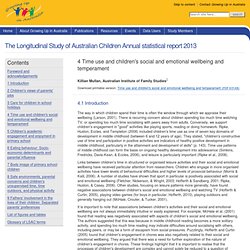

Www.responseability.org/__data/assets/pdf_file/0007/4885/Educators-Guide-for-the-website.pdf. [rd]Towards a ‘good life’ for children in their middle years. School Photo ©Amanda James.
![[rd]Towards a ‘good life’ for children in their middle years](http://cdn.pearltrees.com/s/pic/th/towards-children-middle-years-89763248)
Used with the permission of the Australian Child Wellbeing Project. Petra Lietz describes a new research collaboration to design and conduct Australia’s first internationally comparable survey of student wellbeing, with a particular focus on disadvantaged students. The wellbeing of children in their middle years is important for their current quality of life, and for their future development. Wellbeing can be broadly understood as people’s material and environmental circumstances, relationships, and how they think about themselves in the context of those circumstances and relationships. While there is a growing interest in Australian children’s wellbeing in their middle years, less is known about how wellbeing varies among different groups of children. Understanding and supporting child wellbeing The first major phase of the project commenced in late 2012 and involved in-depth group work and interviews with eight- to 14-year olds.
Innovative survey design. Child development: 6-9 year old children. Social and emotional development Over these middle years, you’ll see the gradual development of your child’s social skills, and an increasing ability to relate to others.

Your child might have a great desire to fit in and be accepted by her peer group – some degree of peer group acceptance is essential for her self-esteem. At this age, many children want to play with children the same sex as them, and can sometimes stereotype members of the opposite sex. This is normal, and offers you the opportunity to point out that both sexes are capable of doing lots of different things, not just ‘boy’ or ‘girl’ things.
Although children of six and seven share activities and enjoy each other’s company, it’s usually not until they’re eight that they begin to be capable of imagining what it’s like to be another person, and to form sustained friendships. In the middle years, your child might: Developing understanding Your child’s thinking processes are subject to her emotions and self-esteem. The Australian Child Wellbeing Project. Fraser Mustard Centre. 4 Time use and children's social and emotional wellbeing and temperament - The Longitudinal Study of Australian Children Annual statistical report 2013. 4.1 Introduction The way in which children spend their time is often the window through which we appraise their wellbeing (Larson, 2001).

There is recurring concern about children spending too much time watching TV, or spending too much time socialising with peers away from adults. Conversely, we support children's engagement in "good" activities like playing sports, reading or doing homework. Ripke, Huston, Eccles, and Templeton (2008) included children's time use as one of seven key domains of development in middle childhood (between 6 and 12 years of age). They stated, "children's constructive use of time and participation in positive activities are indicators of healthy positive development in middle childhood, particularly in the attainment and development of skills" (p. 143).
Links between children's time in structured or organised leisure activities and their social and emotional wellbeing have received particular attention from researchers. 4.2 Data 4.4 Results.